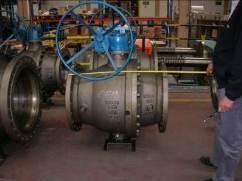Goods Inspection
The goods inspection article provide you with information about second or third party inspection activities, which are done to confirm delivered goods have the same specifications that were stated in the purchase order.
Goods Inspection - Scope
The scope of work for goods inspection is very similar to that of pre-shipment inspection.
Goods and commodity inspection have the same meaning and same definition and refer to the inspection of specific goods that a buyer purchases from seller.
The buyer might be the end-user, an engineering company under the contract of an end-user, and the seller might be an equipment manufacturer or its distributor or individual supplier.
Generally, the inspection scope includes the following: document review, visual quality and quantity inspection, packing, marking and loading inspection. The scope of inspection has more of a commercial approach than a technical approach. Sometimes goods inspection is accompanied by shop inspection.
For more details, review the Shop Inspection article.
Shop or Vendor Inspection refers to the inspection activities that are done during the manufacturing process, but goods inspection is a term which is normally is used for finished material or equipment inspection.
This is the reason for goods or commodity inspection,we say visual quality inspection and not quality inspection, but to-day's in industrial equipment shop inspection and goods inspection are done together.
Goods and commodity inspection is also called pre-shipment inspection.
But there is some scope of work in pre-shipment inspection that is not included in the goods or commodity inspection, such as price verification services to the customs authorities, etc.
For more details, review the Pre-Shipment Inspection article.
Based on the agreement between the buyer and seller, the goods might be inspected by the buyer's own inspector or independent third party inspector.
The proforma invoice, purchase order, letter of credit, goods specification and drawing must be reviewed by the inspector before the physical inspection of goods can occur.

The third party inspector must provide an inspection visit report to the purchaser and issue the inspection release note if the inspection result was satisfactory.
By receiving the release note, the seller can organize for shipment. It is necessary to notify the shipment date to the inspector in advance (if the loading inspection is in the scope of inspection).
If the purchase fund is transferred through a letter of credit, then the third Party Inspection Company must issue an inspection certificate.
The inspection certificate is almost always issued after the shipment of the goods.
The documents that must be submitted by the seller to the inspection company for issuing the inspection certificate are the bill of lading, certificate of origin and signed and approved packing list.
For more details review the Certificate of Inspection article.
But if the goods value is paid with T/T (Telegraphic Transfer), in other words through a wire transfer system, then these formalities are not necessary.
But this is done only for small purchases or when the buyer and seller trust each other and do not want to spend lots of time opening a LC and following the procedures.
In the T/T payment method, the inspection certificate is not necessary, and the inspection report and release note might be enough for the buyer.
The scope of inspection depends on the buyer. They might order a third party inspection company for 1 man-day and request a visual inspection, quantity check, packing and marking inspection or order several days to witness some tests.
Goods Inspection - Example
For example, assume a buyer wants to purchase 150 air compressors from a compressor manufacturer or its distributor. Then the buyer can hire a third party inspection agency for 1 day just to make the document review (Drawings, test reports, material certificates), visual inspection, packing and marking control, or can hire a independent third party inspection agency for 5 man-days and ask him/her to witness all compressor performance tests and also do the visual, packing and marking inspection.
Definitely, the inspection cost will be higher in the second option, but the risk of receiving non-conforming compressors will be less.
The purchaser must optimize the cost of inspection and the scope of work. In the above example, in the second option, the third party inspection company has made a shop inspection as well as a preshipment or goods inspection.
For more supplementary information on this subject, you may review the Goods Inspection Services article.
2 Free CPD Hours Courses - Completely Free
Enroll, Watch the Video, Take the Test, Download Your Cert and Submit to the API . 2 free courses are availble each with 2 hours credit. (Total 4 hours) - 1) ASME V Articl II , 2) ASME V Article 6 & 7